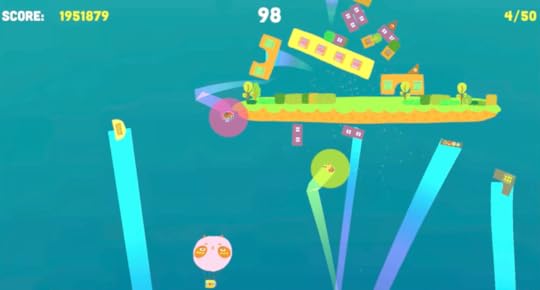Kill Screen Magazine's Blog, page 228
September 10, 2015
The abandoned Japanese town that inspired PS2 horror game Siren is predictably unsettling
Graveyard town.
Hiroshima's Street View for Cats is basically an RPG
“Japan just created a Google Street View for cats,” reports Vox’s Margarita Noriega, which sounds like a pretty good deal. A series of maps and visualizations created by Hiroshima prefecture’s tourism board, show a number of popular routes from the just-above-ground POV of a feline. As you stroll through marketplaces and other thoroughfares in street view, abstracted cat icons indicate the homes of other furry friends.
These maps are of no use to Hiroshima's cats
These maps are, of course, of no use to Hirohsima's cats, which may appear online with alarming frequency but cannot actually navigate the internet. As the Wall Street Journal reported:
“We were seeking to introduce a different way to look at our cities and offer a view of the streets that wasn’t available before,” a Hiroshima tourism official said. They decided on a cat’s-eye view because Onomichi, a port town known for its large number of cats, is also home to a museum dedicated to Japan’s ‘maneki-neko’ cat dolls, the official said.
Hiroshima’s cat maps are not useful for navigation in any traditional sense, but that doesn’t mean they are without uses. They allow you to view the world from a different perspective. As Vox’s Margarita Noriega noted, “I learned two lessons about the nature of cat lifestyles by browsing the maps. First, everything is a door. … Second, roads are entirely too big when you're so small.” These lessons, incidentally, are similar to those that can be gleaned from Dog Park developer Kevin Cancienne’s “City Dog.” Dogs and cats: not so different after all.

The cat maps, as with early, inaccurate maps, are primarily useful as cultural artefacts. Want to know how a self-driving car thinks? Look at its maps. The same holds true with cats. “The Japanese Internet cat has become a crucial proxy,” Gideon Lewis-Kraus wrote in his lovely feature on the nation’s famous cats. “People who feel inhibited to do what they want online are expressing themselves, cagily, via the animal that only ever does what it wants.” In that respect, Hiroshima’s cat Street View ultimately functions like a limited RPG, immersing you in a world you may have missed out on.
The bittersweet pleasures of patriarchy lite
The post-masculine media, from TV to games.
Slam City Oracles is a royal riot grrrl rumble
Sign up to receive each week's Playlist e-mail here!
Also check out our full, interactive Playlist section.
Slam City Oracles (PC, Mac, Linux)
BY Jane Friedhoff
You know that feeling you get when you're around your bestie? It's like you're invincible and could destroy or save the world together (depending on your mood). That's exactly the sensation captured by Slam City Oracles, a multiplayer physics game that gives you points for simply having fun and taking control with a friend. You fly around a Katamari Damacy-like world filled with nonsensical inhabitants and buildings that seem to exist for the sole purpose of goofy play. You can swoop by stacks of pizza and a spinning Ferris wheel. Or you can take a nosedive to send them into your chaotic orbit as wonderful words of encouragement flash across the screen. You can always try harder to make a bigger impact but you cannot lose in Slam City Oracles. Taking inspiration from riot grrl culture and having an all female creative team (including art by Jenny Jiao Hsia and a soundtrack by the Brooklyn band Scully), the game is a teen girl's haven where pink power rules over a world of ice cream and rainbows.
Perfect for: Lalala from katamari damacy, princesses of punk, thrill seekers with a sweet tooth
Playtime: Four Minute Rounds

A Two5six conversation with Forza���s Dan Greenawalt and BMW designer Chris Bangle
The future of car culture, in a world where kids don’t even want driver’s licenses.
September 9, 2015
An Aphex Twin tribute morphs the virtual body into horrifying shapes
Richard D. James (better known as Aphex Twin) has often seen his songs associated with disturbing, warped bodies. In the early '90s, the label he co-founded and that produced his music, Rephlex Records, described his style as "braindance." Pitchfork's Paul Cooper wrote about this terminology in 2002, saying that "'braindance' escaped the mind/body binary opposition of electronic music-- here was a rhythmically hyper, complex genre that retained its club roots by appending fantastically supple limbs to the listener's fervid imagination."
The corporeal imagery conjured there is hardly an embellishment on Cooper's part. By that time, the music videos directed by experimental film maker Chris Cunningham for Aphex Twin's songs "Come to Daddy" and "Windowlicker" were years old. Cunningham brought to life James's plastering of his own leering face on the covers of his CDs where it remains intensely and eternally menacing. In those videos, that fixated stare becomes a mask, superimposed on other people's bodies, snarling and stretching into demonic portraits that make you ill with nightmares.

Cunningham took this contortion of the human body further with his experimental short film "Rubber Johnny." In it, a hydrocephalic teenager stuck nude in a wheelchair contorts limbs and flesh to the erratic snare rushes and cacophonous electronic twitches of Aphex Twin's song Afx237 v.7 (from his album "Drukqs," which the video was originally being made for as a TV advert) as part of a bizarre, lonely rave.
a puddle of melted skin, bone, and hair
After being slapped by a disapproving father and snorting a line of cocaine, the titular Johnny sporadically morphs into a mess of deformed limbs amid black space, distorting himself into new knots before you have time to take any of it in. This is followed by a section in which he is seen repeatedly pressed against glass in new positions. He's squashed to resemble a puddle of melted skin, bone, and hair; sentient offal. The only sign of life is the mouth that screams between tongue and teeth to match the breakdown of the music, which by this point has reduced to jarred computer error sounds. Where the music transgresses standards in form and meter so, too, does the physical body.
The association here is more than a unity of body and mind, as Cooper previously said, but also of flesh and technology—the former's behavior conducted by the sounds of the latter into a horrifying performance. And it's this that Mau Morgó captures in his tribute to Aphex Twin's music (specifically the track Alberto Balsam as it plays throughout) and Cunningham's videos, which he's titled "I did this for Richard D. James, but he doesn't know."
Morgó explains that this project was commissioned by someone but they never published the finished work. And so, a year and a half after having completed it, Morgó has published it himself. It comes with a brief description: "Rubber Johnny also has dreams. He is not in a wheelchair. He may run or fight them, but they will always be with him."
You can interpret the video as you wish but, with this description, the popular reading will probably be that this is Rubber Johnny having a beautiful if strange dream. It makes sense if you roll with that as he appears to enjoy the physical flexibility that the dream enables beyond his restricted state during consciousness. And it's a great concept to realize in 3D modelling and animation software as it makes that connection between bodies and technology that has always orbited Aphex Twin's music—whether in our own minds while listening, or realized in Cunningham's music videos—much more immediate, and unites them in dance.
Tale of Tales teases new project called Cathedral in the Clouds
Tale of Tales, the creative duo behind The Path, Luxuria Superbia, and most recently, Sunset, announced in June that they would stop making games—commercial ones, at least. Sunset, despite earning good reviews, was a financial failure according to their blog post on the subject, and at that point, it simply became unrealistic for them to pursue game development the same way again. Enter: Cathedral in the Clouds.
Cathedral in the Clouds is the newest project from Tale of Tales, but there’s no public information on what it is yet. Its Twitter account contains only a logo, a bio that describes the title as “A tale of tales. But not a game!” and a tweet featuring panoramic shots of the Notre-Dame Basilica in Montréal.
videogames are like cathedrals
It’s unclear whether the “not a game” description literally means that this latest project is truly not a videogame (most likely), or if Tale of Tales is playing with words again.
What I do know is that Tale of Tales says that videogames are like cathedrals—"a narrative environment, an environment that immerses you in a story, in a time. It’s a time machine. It’s made over hundreds of years." You can read that full interview on GameChurch.
Sign up for the Cathedral in the Clouds mailing list on its website.
Prepare for the mind melting audio-visual journey of Panoramical
Probably the most gif-able game this year.
Glitch Noir looks into the corporate drone hell of our near future
The Candidate, director Michael Ritchie’s 1972 political satire, depicted an exaggerated political milieu in which even the most earnest of candidates is shallow and ultimately believes in nothing more than getting elected. Ritchie’s exaggerated world, in other words, is the world we now live in. Therein lies the risk and perverse beauty of genre cinema: sometimes a filmmaker’s transgressive vision becomes our everyday reality.
Writer, director, and animator Cody Healey-Conelly’s Glitch Noir is a genre short whose dystopian future may imminently be upon us. It is about streams of information and the use of drones. More specifically, a major company’s drone fleet has started to malfunction and poses a threat to the populace. Deaths occur. To nobody’s surprise, the responsible corporation cares less than it should and experiences less suffering for its sins than it probably should.
That last sentence is probably a spoiler, but how can one spoil the present day? Glitch Noir’s bleak future is so close to the present that its conclusions are largely knowable from the start. Sure, this future is couched in a mix of film noir graphics, Roy Lichtenstein pop-art, and glitchy web graphics, but its IRL equivalent is readily apparent. (Gee, can you think of a company with a forthcoming drone fleet that could never possibly ever, ever malfunction? Why on earth would you ask that question?)
The IRL equivalent is readily apparent.
Glitch Noir arrives at a time when the corporate and digital malfeasance is an important cultural theme. Last week, Mr Robot finished its ten episode first season run on USA. Its finale highlighted the high costs of corporate plans gone awry, but also hinted at the possibility that large corporations tend to come out on top in the end. Glitch Noir takes this conclusion and runs with it. (In another Mr Robot parallel, Glitch Noir’s villain is named Tyrell. Please feel free to send your theories about Mr Robot’s Tyrell Wellick to Kill Screen.) None of these works appear as speculative as The Candidate, but in the digital age of genre storytelling, we no longer have time speculate.
Searching for a hat in the White March
Pillars of Eternity’s White March expansion is cold and thin.
Kill Screen Magazine's Blog
- Kill Screen Magazine's profile
- 4 followers



